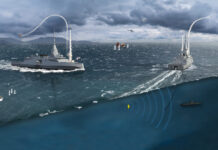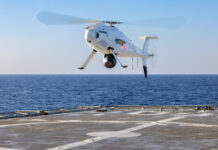The Hellenic Navy’s (HN) new frigate will be a “high end” multipurpose/multimission frigate with advanced capabilities in anti-air, anti-submarine, and anti-ship warfare. These frigates will ensure the navy’s core, traditional war-fighting capabilities remain effective for the next 15 – 20 years.
Background
The Greek coastline is around 15,000km, including 227 islands. To the west, Italy, Turkey to the east. Albania, North Macedonia and Bulgaria to the landlocked north: to the north-east a 200km / 120mile land frontier with Turkey. On the three remaining sides are the Adriatic, Ionian, Mediterranean and Aegean seas. Greece shares a Joint Defence doctrine with Cyprus. The Hellenic maritime capability requirement is significant. On 5 June 2021, Prime Minister Kyriakos Mitsotakis announced the intention to acquire four heavy frigates, alongside an MLU for the existing HYDRA-class frigates.
Missions and Assets
Generally, the mission of the HN is to deal with any external threats and provide patrol support to the Hellenic Coast Guard (for which latter task a corvette may be a suitable, smaller platform.) Theoretically, heavy corvettes could be procured to replace the four ELLI class ships not updated in the 2004-2009 MLU programme. The HN is thought likely to acquire modified (larger) Israeli SA’AR 72 corvettes from Israeli Shipyards and their Greek partner, ONEX Neorion Shipyards – the THEMISTOCLES class – but these are 800-ton vessels outside the scope of this report.
Frigates are the main heavy ships of the HN. There are 13 in service: four HYDRA class and nine ELLI class. The HYDRA class is a modified Blohm & Voss MEKO 200 design, subject of intermittent upgrades from 2007/2008 onwards, as funds permitted. The lead ship of the ELLI class is now some 40 years old. Six of the ELLI class were modernised in 2004-2009; the other four (including one decommissioned in 2013) will be replaced under the new frigate programme.
Regional Security and Challenges
Since 2016 the EU, with additional funding from member nations, has paid Turkey to host the Turkish Facility for Refugees, which currently accommodates some four million people. That programme is funded until 2021-2025, also at €1Bn annually. In early 2020 the Turkish government unilaterally opened its border with Greece, and the influx of refugees by land and sea began again.
Maritime boundaries in the eastern Mediterranean have long been in dispute, particularly over energy resources. The situation was inflamed in early 2021, when Turkish Navy warships opened fire on HN coastguard vessels: it is necessary for the HN to be able to discourage similar actions in the future.
The HN Shortlist
In alphabetical order the shortlisted shipyards are:
- Babcock (UK) with the Type 31/ARROWHEAD (approx. 6,000 tons displacement)
- Damen (Netherlands) with the SIGMA 11515 (displacement approx. 4,400 tons)
- Fincantieri (Italy – allegedly with the FREMM) (displacement approx. 6,000 tons)
- Lockheed Martin (USA) with the FREEDOM class MMSC (LCS) (displacement approx. 3,500 tons)
- Naval Group (France) with the FDI/BELHARRA (approx. 4,400 tons displacement)
- TKMS (Germany) with the MEKO A200NG (or MEKO A300) (approx. 5,500 tons in Polish Navy configuration – the MEKO 200HN displaced around 3,400 tons)
Early Days
The acquisition of up to four Naval Group FDI BELHARRA class frigates from France, with high-end AAW and Deep Missile Strike capabilities was put on hold in July 2020, reportedly due to the cost – almost €3Bn for only 2 units – the lack of local production opportunities in Greece and the late proposed delivery of the first unit, in 2025 at the earliest.
The US proposed the acquisition of four Multi-Mission Surface Combatants (FREEDOM class MMSCs) developed by Lockheed Martin. On 6 November 2020, the HN submitted its acquisition request for four MMSC frigates; part of a package including the HYDRA upgrades, “intermediate solution” ships, and participation of Hellenic Shipyards in the US FFG(X)-type frigate development.
The FREEDOM-class is in full production for Saudi Arabia, and “tested and in-service” with the USN. But the class’s appalling reliability record is reported to have resulted in the USN declining new deliveries between January and June 2021; a delay to full USN mission capability until “at least” 2023; and early decommissioning by the USN – in the case of the US$300M-US$350M USS LITTLE ROCK less than six years after commissioning.
Two types might replace the ELLI class. One idea, to purchase heavy corvettes, has gained traction since Greece joined the EPC programme, but the EPC is only half the displacement of some “proper” contenders, and on closer examination can probably be dismissed. Even allowing for a cheaper, faster EPC build (unlikely in a multinational consortium), an earlier in-service date (probably not before 2027), and substantial offset / technology transfer / workshare (wishful thinking), the capability shortfall seems decisive.
TKMS is offering the MEKO-A200, a new and advanced version of the MEKO-200HN, offering increased homogeneity to the fleet, especially after the upgrade of the ships already in service.
The Frigate Contenders
All companies involved were invited to elaborate on their propositions for the HN Frigate Programme. Babcock International and Naval Group are presented alphabetically.
Babcock International claims that it is creating a “game-changing” approach to global shipbuilding to offer warship design, build and in-service support options to international navies through its ARROWHEAD 140 general purpose frigate. For Greece, supported by the UK Government, Babcock has developed a programme meeting all the HN’s requirements, including:
a) a HYDRA class upgrade
b) an interim frigate capability
c) four Babcock ARROWHEAD 140 frigates.
ARROWHEAD is the design chosen by the Royal Navy for the Type 31 programme. The company offers a package of support and industrial strategy supporting the modernisation of key Greek shipyard facilities, with partnership offers to Greek industry to develop local workforces and transfer knowledge and technology across the wider domestic shipbuilding supply chain.
Babcock
ARROWHEAD 140 is a proven, adaptable design based upon an in-service hull-form that has been tried and tested in real-world operational environments: a cost-effective, high-value vessel designed for in-country build. Because the design is selected for the Royal Navy’s next generation frigates it offers accurate known costs and significant economies of scale. According to Will Erith, Chief Executive Marine, “…The buildability of the ships ensures the effective transfer of a UK design to Greece for efficient manufacture and in-country assembly, while de-risking the build programme… We will work with Greek industry to utilise domestic supply chains, to modernise and equip facilities, upskill and grow local workforces and transfer knowledge and technology to support an in-country build that will stimulate economic growth and prosperity.”
Offer Specifics
- Propulsion; the platform can accommodate various propulsion solutions and is big enough to embark sufficient fuel for long-range, independent, global operations.
- Armaments; the platform can be fitted with a range of high-end capabilities. Offensive and defensive systems for enhanced air defence, surface and sub-surface warfare, maritime interdiction, self-protection and engagement of long range land targets provide significant strategic, political and operational choice and operational confidence.
- Mission Systems; the RN ARROWHEAD 140 incorporates the TACTICOS™ CMS, with open architecture and computing environments to provide a scaleable, upgradeable mission / combat management capability.
- Aviation; the flight deck accommodates a wide range of naval aircraft and air systems. The hangar can berth an organic medium naval helicopter such as a MH-60 SEAHAWK, plus various unmanned air systems.
- Ammunition Handling; dedicated facilities to store and prepare air-launched weapons, including ASW torpedoes and Anti-Surface missiles, are provided. The flight deck can launch and recover non-organic aircraft weighing up to 15 tons.
- Accommodation; ARROWHEAD 140 can operate with a Ship’s Company of fewer than 100 people. It has dedicated accommodation for 180+ personnel, plus additional temporary accommodation and can carry a significant Embarked Military Force – such as Special Forces, littoral manoeuvre troops or additional C2 specialists.
- Through-Life Support; Babcock’s through-life support assures ship availability, reliability and cost-effective readiness, including optimal integration of people, processes and technology. The latest mobile, remote and connected technology ensures systems can provide operators and maintainers with in-depth understanding of the performance, maintenance and material condition of their assets.
Naval Group
Naval Group submitted a new offer for the modernisation of the Hellenic surface fleet, as part of the French Team that also includes MBDA. The team described its offer as “comprehensive and robust… designed to ensure Greece has the best capabilities in the shortest timeframe with optimised costs.” The package includes:
a) four FDI HN – three built in Greece, the first in-service by 2025 along with a “Gap-Filler” solution of two frigates available in early 2022
b) modernisation of the MEKO frigates in Greece
c) an ambitious Hellenic Industry Participation (HIP) plan.
The French offer “will ensure that HN capabilities are enhanced to meet immediate and future needs, while creating and sustaining jobs and economic benefits for the country over decades to come.”
The FDI HN will be fitted with a weapons mix offering significant control of air and sea space, and autonomy in support of political and military objectives. It incorporates some of the best technologies from Europe’s defence industries, particularly MBDA and Naval Group. The ASTER system gives 360° coverage and can counter saturation attacks, and the FDI can accommodate Naval Cruise Missiles and a Deep Strike capability. Physical and digital infrastructures of the FDI offer evolutionary potential for the life of the ships. The first FDI HN would be delivered in 2025. Naval Group offers a reduced-risk solution for the construction of the three subsequent FDI HN in Greece, by Greek shipyards, on time, and with the same quality and performance as the France-built first of class.
Gap Filler Solution
The French offer includes two Anti-Air Warfare (AAW) and Anti-Submarine Warfare (ASW) frigates, to be delivered to Greece in 2022. Both frigates are operational in the French Navy, proving they are fully capable and interoperable. MEKO Modernisation in Greece. Naval Group has formed a local partnership for the MEKO upgrade that guarantees operational availability and is executed in Greece.
Hellenic Industry Participation Plan (HIP)
The involvement of Hellenic industry “will enhance the country’s excellence in the naval domain and create long term economic benefits and jobs as well as ensuring the warships will be maintained in Greece by Greek industry.” The HIP will sustain “thousands” of highly qualified jobs and generate long-term economic benefit: “FDI HN: made in Greece, by the Hellenic Industry, for the Hellenic Navy!”
The HIP plan will contribute to the revitalisation of Greece’s defence shipbuilding industry, by transferring all the necessary technology and knowledge, maximising Greek industry in-service support for the next 40 years, and participating in the long-term development of profitable, innovative, highly qualified jobs for Greek citizens – not only shipyards but also in electronics, IT, and more. Naval Group is already in contact with most if not all Hellenic companies that might join the FDI HN programme. All qualified Greek companies will be integrated into the French industrial team’s supply chains, thus able to participate in and benefit from future international competitions.
Naval Group has strong interest in R&D projects with Hellenic organisations in cutting-edge technologies, and is looking to develop a network of technological and research projects upon which to build future naval warfare capabilities.
The Others
TKMS responded to our invitation, with a polite refusal to reveal specifics of their strategy, solutions or promises. There was no response from Damen or Fincantieri in the time available.
Conclusion
This is an interesting programme, with a range of possible solutions, from sub-3000 ton corvette to frigates double the size. It has clearly taxed the imagination of industry in terms of adding value and creating solutions to problems that mostly revolve around urgency but are significantly challenged by the real world of money, risk and threats. Its successful launch and conclusion will be a hugely positive sign for Greece, the EU, NATO and the eastern Mediterranean. The final Hellenic Government decision remains scheduled for 2021.










